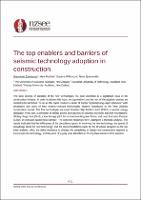| dc.contributor.author | Zarinkamar, Shermineh | |
| dc.contributor.author | Poshdar, Mani | |
| dc.contributor.author | Wilkinson, Suzanne | |
| dc.contributor.author | Quenneville, Pierre | |
| dc.date.accessioned | 2021-06-22T04:02:08Z | |
| dc.date.available | 2021-06-22T04:02:08Z | |
| dc.date.issued | 2021-04-14 | |
| dc.identifier.uri | https://repo.nzsee.org.nz/xmlui/handle/nzsee/2435 | |
| dc.description.abstract | The slow process of adoption of the new technologies has been identified as a significant issue in the construction industry. In order to address this issue, the top enablers and barriers of the adoption process are needed to be identified. To do so, this paper conducts a series of twelve "systematising expert interview" with developers and users of four seismic-resistant technologies recently introduced to the New Zealand construction market. The four technologies included Resilient Slip Friction Joint (RSFJ), a seismic energy dissipator; Press-lam, a connector of timber beams and columns or columns and walls and their foundations; Sliding Hinge Joint (SHJ), a low damage joint for moment resisting steel frame; and Lead Extrusion Damper (LED); an extrusion-based metal damper. The collected responses were undergone a thematic analysis. The results indicated that the willingness of the consultancy group in involving the new technology, the spread of knowledge about the new technology, and the recommendations made by the structural designers as the top three enablers. Also, the client resistance to change, the complexity of design and construction required to incorporate the technology, and the place of supply were identified as the top three barriers of its adoption. | |
| dc.language.iso | en | |
| dc.publisher | New Zealand Society for Earthquake Engineering | |
| dc.relation.ispartofseries | 2021;0109 | |
| dc.subject | Innovative approaches in seismic design and assessment | |
| dc.subject | Advancements in structural and geotechnical design and assessment | |
| dc.title | The top enablers and barriers of seismic technology adoption in construction | |
| dc.type | Article | |

